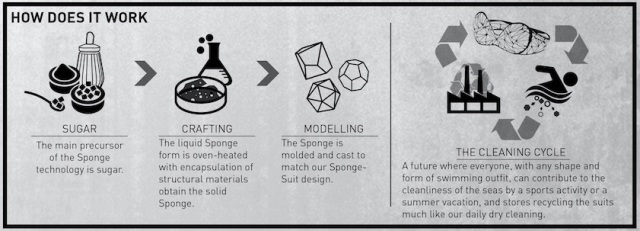A unique sponge-like material, that adsorbs pollutants from its surroundings, has been developed by a team from the University of California. The researchers have collaborated with a design agency to form an award-winning swimsuit that keeps you dry whilst purifying the water around you.
 Illustration showing how the Sponge material was created.
Illustration showing how the Sponge material was created.
The new material, called Sponge, is produced from heated sucrose and can be reused multiple times. It features a highly porous structure that is capable of absorbing toxic contaminants whilst being super-hydrophobic, i.e. resistant to water.
The material has capacity to take up up to 25 times its own weight in pollution. Following use the pollution can then be safely removed by heating the swimsuit to a temperature of 1,000 °C.
The material's outer layer is covered in pores which trap contaminants, whilst ensuring none come in contact with the skin. After repeated use the sponge pad can be taken out and recycled, and a new pad can be used in its place. UC Riverside labs tested this material, and confirmed that it can be reused up to 20 times without affecting its absorbency.
This is a super material that is not harmful to the environment and very cost effective to produce.
Prof Mihri Ozkan - Uuniversity of California, Riverside
The research team included Ozkan her husband and fellow engineering professor, Cengiz Ozkan, Hamed Bay and Ph.D. student Daisy Patino. Approximately four years ago, the team started to develop the material to clean up chemical and oil spills and also for water desalinization purposes.
Since the material repels water it can be used in paints that are specifically developed for satellites and airplanes or can even be used in unmanned aerial vehicles as a component of electromagnetic shields.
The unique idea of using the Sponge material in a swimsuit was proposed by Eray Carbajo, an architecture and design company. The firm is located in Istanbul and New York City. This group worked with the Ozkan team to develop the swimsuit, which went on to secure the top place at the Reshape 15 Wearable Technology Competition.
The swimsuit will also be showcased at the Maker Faire in Rome on October 16, 2015.
With the help of the new design the Sponge material is molded into a shape of swimsuit and is enclosed in a cage fabricated using a 3D-printed elastomer. This cage appears like a net which then molds to the body. The Sponge material could even be used in wet suits and swimming caps.
Patents for this latest invention have been filed by the UC Riverside Office of Technology Commercialization.